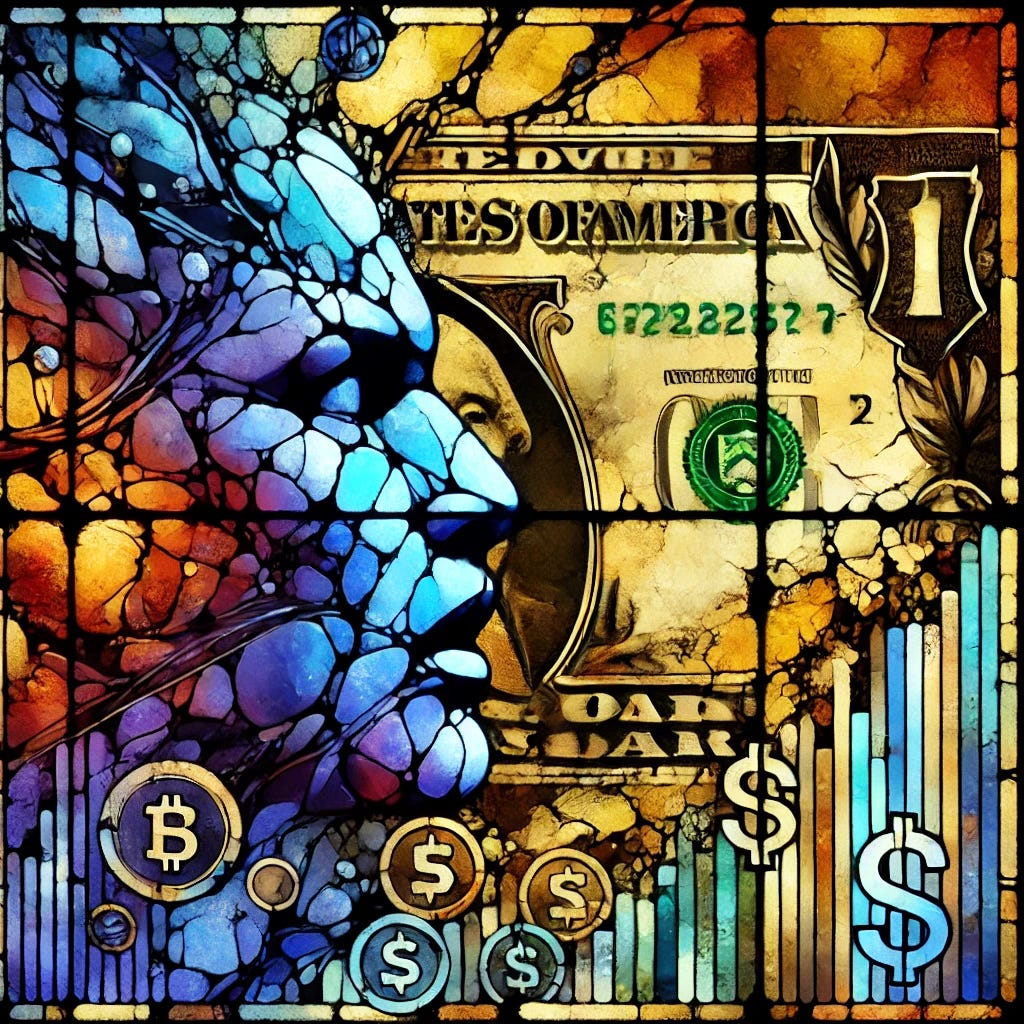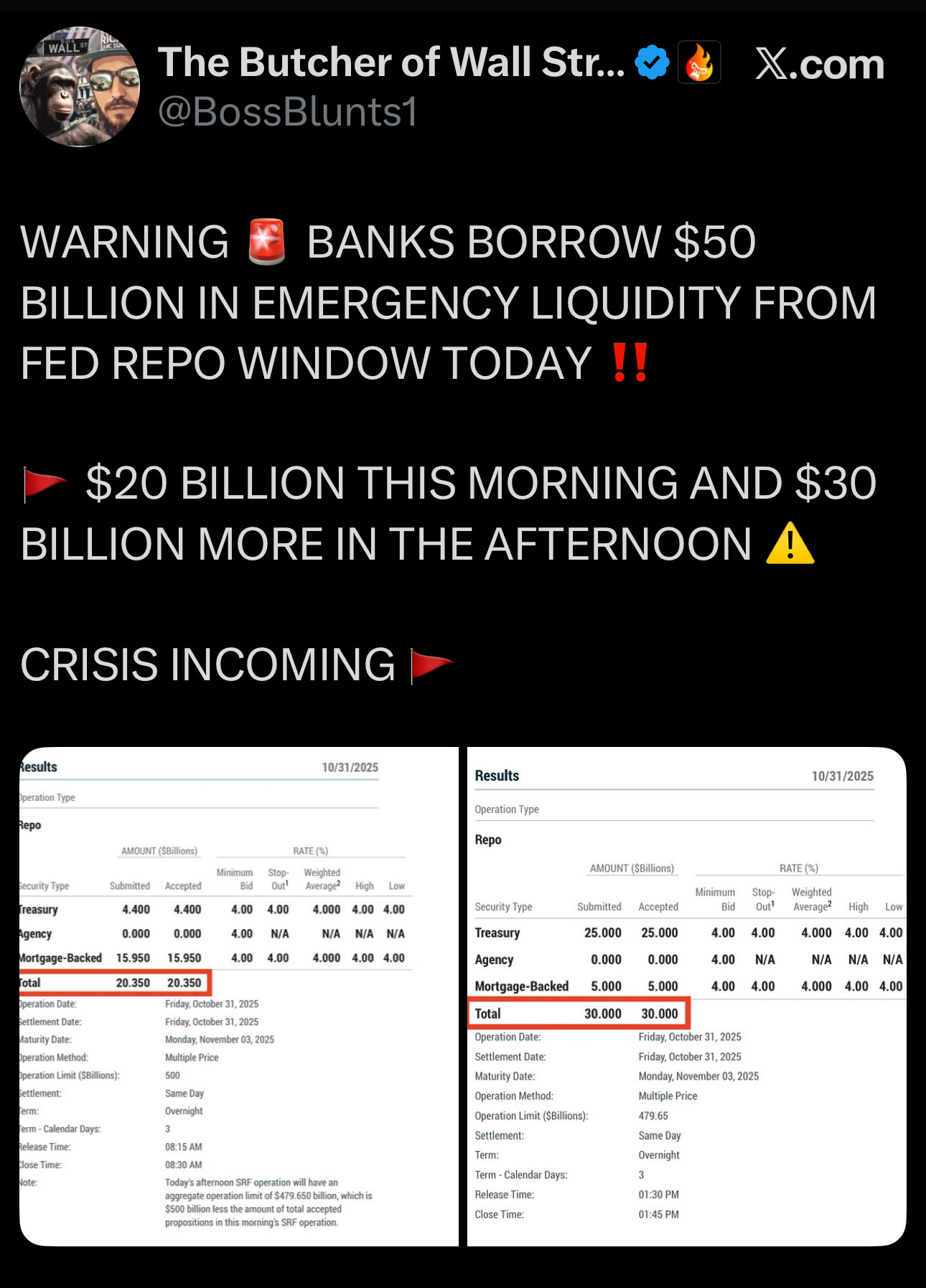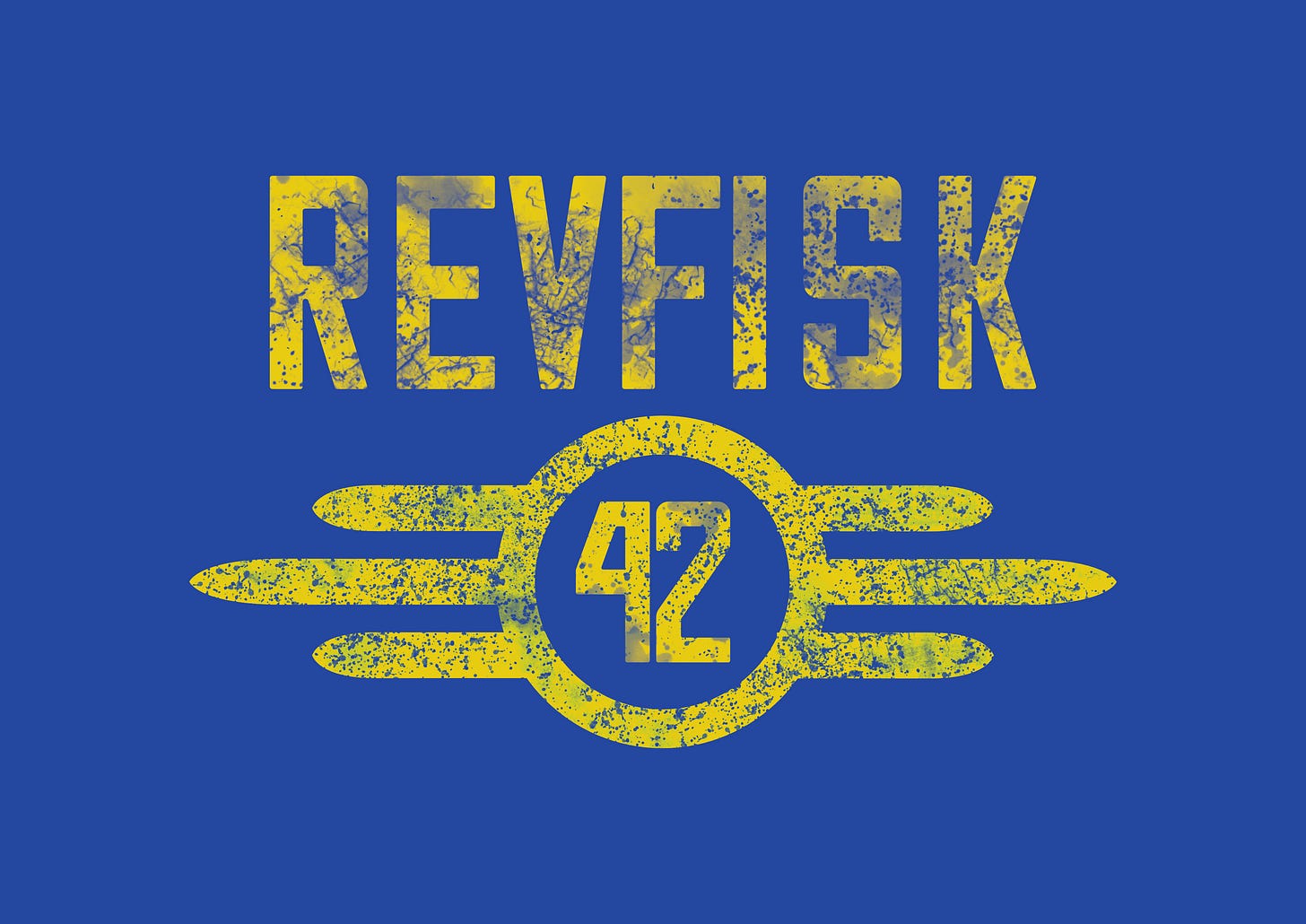Friday’s Fifty Billion
A Breath the System Couldn’t Skip
Late on a quiet Friday, at the end of the fiscal month, a number flickered across the Federal Reserve’s screen—fifty BILLION dollars. No press conference, no sirens. Just a line of code in the Fed’s “Standing Repo Facility” showing that the biggest banks in the world had come, cap in hand, for an overnight loan.
Most Americans will not hear it happened. A few traders saw the print and frowned. A few screamers on X shouted, “Monday is the end of the world!” Ask Chat or Grok and they’ll just press out a new spin on “quantitative easing” made standard weekly practice. But in the plumbing of the dollar system, that fifty billion was a gulp of air—a breath the system could not skip.
What actually happened
The Standing Repo Facility, or SRF, is the Fed’s oxygen tank. When a bank is short of cash at day’s end, it can hand the Fed a pile of U.S. Treasury bonds as collateral and borrow dollars overnight. On Monday morning it gives the money back, pays about four percent interest, and takes its Treasuries home again. “Oh. That’s all.”
It’s supposed to be boring.
Except that normal daily usage hovers near zero and on Friday, October 31, 2025, the system drew roughly $50 billion, split between two sessions—$20 billion in the morning, $30 billion in the afternoon.
That is the largest single-day draw since the SRF was born in 2021. Technically, it isn’t “money printing.” It’s a one-night swap: debt (on debt, on debt—but don’t ever audit the Fed) for cash.
The size tells you something: the world’s reserve-currency machine had to inhale deeply just to make it through the weekend.
Gasp for breath. Take a deep inhale. Try not to cough.
Why? Because banks and dealers were collateral-rich and cash-poor. (i.e., they own everything, but have nothing.)
Month-end reporting rules reward them for looking smaller on paper, so they shed reserves for a day to polish their ratios, then borrow them right back through the SRF. That practice—“window dressing”—is as old as double-entry bookkeeping by Vinny in the back of the pizza parlor. Yet this time, Vinny might be in over his head. The biggest take on record means the margin for error has thinned to the skin on your teeth. The dollar bloodstream is running low on red blood cells, and the blood bank is flush full of spike-protein.
The economy as a body
Liquidity is the oxygen of commerce. It’s the air that keeps every transaction alive—from a paycheck to a mortgage to a Treasury auction. When the flow slows, the patient doesn’t die at once; he starts to wheeze. Each repo, each emergency facility, is another gasp. The central bank opens the valve, the chest rises, and we all feel fine for another day.
What the system calls “illiquidity” is shortness of breath. The lungs are full of promises—IOUs, derivatives, layers of claim on the same underlying debt—but there isn’t enough fresh air, enough real cash or trust, to circulate freely. Every breath requires more effort than the one before. The body isn’t sprinting toward growth anymore; it’s panting to stay upright on a treadmill that’s quietly sliding downhill.
The debt behind the debt
Those “securities” the banks post as collateral are U.S. Treasury bonds—pieces of national debt that exist only because prior debt created them. They are considered risk-free, yet they are promises backed by promises. In a just-weights world, they would be receipts for stored value. In ours they are claims on future labor, rolled forward forever.
So when a bank borrows from the Fed on Friday and repays Monday, no new wealth appears; only the illusion of solvency is refreshed. The books balance because everyone agrees to believe the numbers. The structure works, but it wheezes.
The metals mirror
Gold and silver have been the traditional barometers of this faith. Their ratio—how many ounces of silver equal one of gold—once hovered near 15 : 1. Today it floats between 70 and 80 : 1. That gap is not natural; it’s the artifact of paper leverage. The financial world trades far more “synthetic” ounces than exist in vaults, suppressing silver’s price relative to gold.
When liquidity tightens, gold is the first refuge. Silver, smaller and faster, is the volatility tail—overreacting both up and down. This autumn’s spike—minor-pull-back/crash in silver/gold ratio followed that script perfectly: traders fled to safety, then fled from their own reflection. The ratio widened, and the mirror fogged again, even as both metals skyrocketed against the shrinking dollar.
A ledger that cannot hide
Enter Bitcoin (17 years ago)—not as a mascot, but as an ontological experiment released from the lab more cunningly than monkeys with herpes.
Bitcoin is a ledger with the audit built in.
Every unit accounted for, every transaction visible, supply forever capped at twenty-one million. Always. That’s its definition. That’s its code. No quarterly reports, no “window dressing,” no need to trust the bookkeeper. The ledger is on every coin, updates with every trade, and is built of coded full disclosure.
It’s not perfect money so much as honest computing. It cannot breathe for the world, but it can show the world what clean breathing looks like.
In contrast, our fiat architecture is faith in Vinny’s books. Bitcoin, as faith in math, lives not by decree, but by proof. That does not redeem all “crypto” from greed or folly, but it does at present stand as a strong alternative to fiat.
The ontology of exasperation
What we saw in the markets last week—the sudden repo spike, the swings in metals, the seesaw in Bitcoin—was not a mystery. It was the ontology of exhaustion: a civilization trying to live by its ledgers rather than by its labor. The accounts still add up, but the meaning behind them has thinned. “Liquidity” now means belief, and belief must be refreshed daily with another loan, or a cut to interest rates, or a sale of more leveraged futures backed by securities backed by loans to people with CDLs that list “No Name Given.”
That is why the system feels winded. This is why no one is eating out. This is what running out of trust looks like.
Honest scales for ordinary people
No one alive can rebuild the world’s ledger overnight. But we can practice honest measure in our own households.
Hold less debt; own more things that do not require someone else’s promise.
Keep a portion of your store in real assets—land, tools, metal, or transparent digital scarcity.
Use surplus to serve your neighbors; charity is the truest liquidity.
And remember that systems fail slowly, then suddenly; people who breathe calmly can walk through both.
This is not investment advice. This is Proverbs 11:1 — “Dishonest scales are an abomination to the Lord, but a just weight is His delight” and 20:23 — “Diverse weights are an abomination to the Lord, and dishonest scales are not good.”
The headline numbers on Friday weren’t the end of the world. They were the sound of a global economy catching its breath—proof that it must now inhale harder every month to keep the same pace. The repo window closed quietly, the screens went dark, and the world kept spinning. But somewhere inside the machine a voice whispered, You can’t hold your breath forever.
As a wise man once said, and now you know … the rest of the story, at least until Monday.










Turning back to PoW is the slow start of a sure snap back to reality. Nobody can outwork the printer. Sound money abstracts real value with clarity and elegant simplicity, and that's good for everyone.
Thanks for a great read this morning.